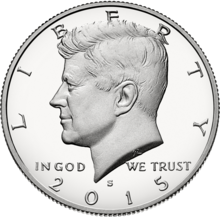
Back نصف دولار (عملة الولايات المتحدة) Arabic Halv-dollar Danish Halbdollar (Vereinigte Staaten) German Dolarduona monero (Usono) Esperanto Moneda de 50 centavos de Estados Unidos Spanish Pièce d'un demi-dollar américain French Amerikai ötvencentes érme Hungarian Կես դոլար Armenian Mezzo dollaro (dollaro statunitense) Italian 50セント硬貨 (アメリカ合衆国) Japanese
United States | |
| Value | 0.50 U.S. dollar |
|---|---|
| Mass | 11.340 g (0.365 troy oz) |
| Diameter | 30.61 mm (1.205 in) |
| Thickness | 2.15 mm (0.085 in) |
| Edge | 150 reeds |
| Composition | 1964: 90% Ag 10% Cu; 1965–1970: 60% Cu 40% Ag 1971–present: 91.67% Cu 8.33% Ni |
| Years of minting | 1794–1797, 1801–1803, 1805–1815, 1817–1921, 1923, 1927–1929, 1933–present |
| Catalog number | – |
| Obverse | |
 | |
| Design | John F. Kennedy |
| Designer | Gilroy Roberts |
| Design date | 1964 |
| Reverse | |
 | |
| Design | Presidential Seal |
| Designer | Frank Gasparro |
| Design date | 1964 |
The half dollar, sometimes referred to as the half for short or 50-cent piece, is a United States coin worth 50 cents, or one half of a dollar. In both size and weight, it is the largest circulating coin currently minted in the United States,[1] being 1.205 inches (30.61 millimeters) in diameter and 0.085 in (2.16 mm) in thickness, and is twice the weight of the quarter. The coin's design has undergone a number of changes throughout its history. Since 1964, the half dollar depicts the profile of President John F. Kennedy on the obverse and the seal of the president of the United States on the reverse.[2]
Although seldom used today, half-dollar coins were once common in circulation and saw regular use alongside other denominations of US coinage, but have become uncommon in general circulation for several reasons. Half-dollars were produced in fairly large quantities until the year 2002, when the U.S. Mint reduced production of the coin and ceased minting them for regular circulation. As a result of its decreasing usage, many pre-2002 half dollars remain in Federal Reserve vaults, prompting the change in production. Presently, collector half dollars can be ordered directly from the U.S. Mint,[2] and circulated half dollars minted from 1971-2001 are generally available at most American banks and credit unions. Beginning In 2021, half dollars were again produced for general circulation.[3]
- ^ U.S. MINT Catalog
- ^ a b "kennedy-half-dollars". United States Mint. Retrieved March 8, 2016.
- ^ Gilkes, Paul. "2021-P Kennedy half dollars now being found in circulation". Coin World. Amos Media Company. Retrieved July 21, 2021.